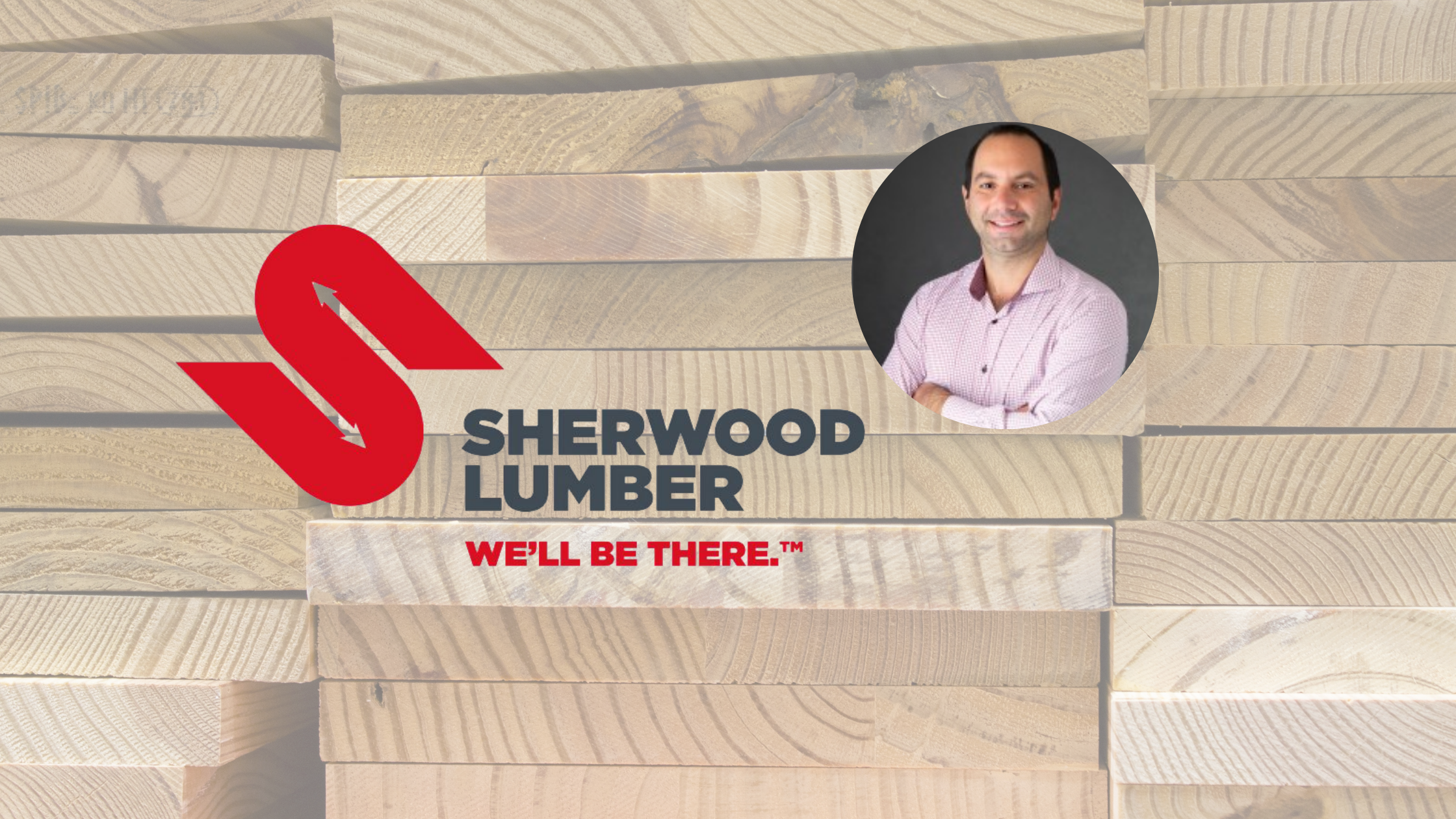The lumber industry faces several challenges driven by fluctuating markets, technological advancements, and shifting consumer demands. For Sherwood Lumber, a family-run business, these changes have presented both challenges and opportunities.
We chatted with Michael Goodman, a third-generation owner and executive team member of Sherwood Lumber, to learn more about the direction that the industry is heading in. Whether you’re an industry insider or simply curious about the evolving lumber trade, here’s an inside look at the lumber industry and its potential future.
The backbone of Sherwood Lumber
For Michael Goodman, the lumber business is more than just a career—it’s a legacy. As a third-generation leader of Sherwood Lumber, he grew up hearing about the industry through his family and observing its challenges and opportunities firsthand. After graduating with an MBA and several years of experience working in various sectors outside the lumber industry, he was eventually drawn back and presented with the opportunity to take on the family business. He couldn’t turn it down.
But being one of the leaders of the family business hasn’t been easy—even with years of experience in the industry and as part of the company’s leadership board. In a market as volatile as lumber, year-to-year conditions can swing dramatically and lead to losses and tight margins.
Despite these hurdles, Michael’s focus on long-term strategies and relationship building has kept the business resilient, proving that adaptability is just as important as tradition.
Current products and services Sherwood Lumber offers
Sherwood Lumber provides a wide range of services designed to meet the needs of retailers, lumberyards, and manufacturers. Focusing on reliability and efficiency, they specialize in delivering premium lumber, panel products, and exterior building materials through their streamlined distribution channels. Their services help businesses solve the logistics behind getting the right materials delivered to their sites on time while staying cost-effective.
Key services include:
- Lumber and plywood: A wide selection of dimensional lumber, studs, and panels in various grades and species, such as Douglas Fir and Eastern White Pine. They also provide specialty panels like fire-rated plywood and marine-grade options.
- Exterior building materials: An array of exterior products, including composite decking, PVC trim boards, and siding solutions like Everlast Advanced Composite Siding and Americana™ Thermally Modified Wood Siding.
- Technical support: Dedicated teams offering product knowledge and advice to tackle project challenges.
- Mill-direct shipments: Access to high-quality materials sourced directly from the mill, cutting out unnecessary delays.
Growth and evolution

Sherwood Lumber’s growth story is one of strategic decisions and a long-term vision. The company has expanded its reach while staying grounded in its values—Reputation, Engagement, Spirit, Pride, Execution, Collaboration, and Transparency (R.E.S.P.E.C.T.). These principles have shaped every decision, from building vendor relationships to fostering a culture of trust and innovation.
One of the most significant milestones in this journey was the launch of their specialty exterior division in 2018. Unlike traditional lumber products such as framing materials, this division focuses on decking, cladding, and trim—areas that require a unique sales approach and specialized expertise.
“This was a six-year grind,” Michael explained, reflecting on the challenges of building the division. “It’s a different game compared to selling framing lumber and plywood. You’re targeting the same customer base, but the sales strategy and personnel are completely different.”
The effort was well worth it. Establishing the division created a more stable foundation in an industry known for its volatility. Unlike standard lumber used for framing, exterior materials tend to have steadier demand and more predictable prices, which helps offset market unpredictability. The growth didn’t happen overnight, though. Michael credits their success to careful planning and a strong team. “You have to be ready to grow,” he explains. “That means ensuring your core operations are strong before you start scaling. We focused on leadership and having the right people in the right roles. Growth only works when your core is solid.”
This philosophy has guided the company’s strategy, enabling them to navigate the lumber industry while staying true to their values.
Navigating the lumber market challenges
The lumber industry is no stranger to volatility, and Sherwood Lumber has had to adapt to a range of challenges to remain competitive. From fluctuating prices to shifts in housing demand, navigating these ups and downs requires a clear strategy and a strong understanding of market forces. For Goodman, managing these challenges begins with understanding the factors driving them.
“Lumber prices are influenced by so many variables—interest rates, liquidity, supply and demand, even the weather,” Michael explains. One of the biggest contributors to price fluctuations is the macroeconomic environment of the housing market. With 80% of Sherwood Lumber materials going to multi-family and single-family homes, changes in mortgage availability, project approvals, and real estate trends have an immediate impact on the company. For Sherwood Lumber to remain profitable, this means keeping a close eye on broader market conditions and responding with agility.
In addition to being agile, having a large list of vendors and suppliers has been extremely helpful in navigating these challenges.
Keys to growth: Building relationships and earning vendor trust
For Sherwood Lumber, vendor trust has been a cornerstone of its success, especially in developing its specialty exterior division. “The barriers to entry might seem low,” Goodman explains, “but logistics and knowledge make this a tough business. You need more than just capital—you need people to believe in you.”
When Sherwood Lumber launched its specialty exterior division in 2018, it started with a blank slate. Convincing their first vendor to take a chance on them was no small task. They could only convince one vendor to work with them in their first full year of running the new division. Yet the grind was well worth it. That first partnership became the foundation for the division’s growth as it proved they could deliver high-quality products and solve logistics.
The following year, Sherwood used the credibility they built with their first vendor to secure two additional partnerships. Sherwood honed their process with each new vendor, learning to navigate the unique challenges of selling exterior materials. Over time, their track record spoke for itself. “Once you prove you can handle the logistics, deliver on time, and maintain strong relationships, other vendors become willing to work with you,” Michael explains.
Fast forward six years, and Sherwood Lumber now works with ten major vendors in their specialty division, some of which initially said no to working with them in their first few years. The division now makes up 20% of their total profit and is only expected to grow. This growth was no accident—it resulted from careful planning, persistence, and an unwavering focus on relationships. Michael admitted to be successful, “You have to be patient and earn trust over time.”
What the future holds for the lumber industry
While Sherwood Lumber has successfully navigated the terrain, there are challenges ahead that will make competition harder. For lumber companies looking to stay ahead, knowing these challenges is essential to establishing future strategies to succeed in the market.
Consolidation
For any lumber or construction company, staying competitive means looking beyond the present and preparing for the future. Michael Goodman sees the lumber industry as poised for transformation, driven by consolidation, technological advancements, and shifts in building practices. “The industry is changing,” he says. “Smaller, family-owned mills and lumber yards are being bought out by bigger players.”
While this inevitably will make it harder for new companies to break in, at the same time, things are going to become more streamlined and less volatile as big players can afford to take larger risks and often have efficient operations. This may lead to lower prices for consumers and builders to work with. However, it’s important to consider lumber is typically only a small fraction of the cost of building an entire home, ranging from 2-5% of the total.
Alternative materials
Another big factor to consider is the potential for alternative materials to disrupt the lumber industry’s demand. For example, materials used in 3D printing, like ABS and PLA, are two alternative materials used to build homes today. Hemp is another sustainable material that people are beginning to use.
However promising, these materials are still in development and likely decades away from being fully integrated like the current lumber industry. Michael believes these materials won’t take off unless they can offer competitive or cheaper pricing than lumber, which is already a sustainable and affordable material itself.
Technology
With AI now going mainstream, it’s only a matter of time before industries like lumber begin using it. Michael sees this as a massive opportunity to innovate and improve efficiency in various areas of the company. The company is looking to integrate AI-driven data management tools to improve efficiency and make smarter decisions about purchasing and inventory. “We want to build a system that can analyze market conditions, predict trends, and help us decide when to buy and when to sell,” Michael explains. These tools will be designed to optimize their operations and reduce the impact of market volatility.
Final thoughts
Sherwood Lumber’s success comes down to building strong relationships, staying adaptable, and always thinking ahead. From earning vendor trust, opening new divisions, and embracing new technology, they’ve found ways to grow while keeping their values at the core. While the future remains uncertain, Sherwood Lumber is well-positioned to succeed in the future market.
Want more stories like this? Subscribe to our newsletter to get the latest stories from industry insiders delivered straight to your inbox.




1 comment
Петр
The story of Sherwood Lumber is a vivid example of how tradition and innovation can go hand in hand in the forestry industry. I resonate with Michael Goodman’s philosophy that growth is impossible without a solid core: a strong team, clear values, and a long-term vision. This precisely reflects our approach at KOLEO.
We also build our business on trust — with suppliers, partners, and clients. For us, wood is not just a material but a strategic resource, and we understand that the stability of the industry depends on how honest and predictable relationships are at every level.
It is important that Sherwood focuses not only on traditional lumber but also on new segments such as exterior materials. This demonstrates that the forestry sector can be flexible and adapt to a changing market. I agree that diversification and the adoption of technologies, including AI, will help the industry cope with volatility and maintain competitiveness.
At KOLEO, we see the future of the forestry industry as a combination of three elements: local resources, innovative technologies, and sustainable management principles. Only in this way can we not just survive but shape the architecture of the future — ecological, reliable, and socially oriented.